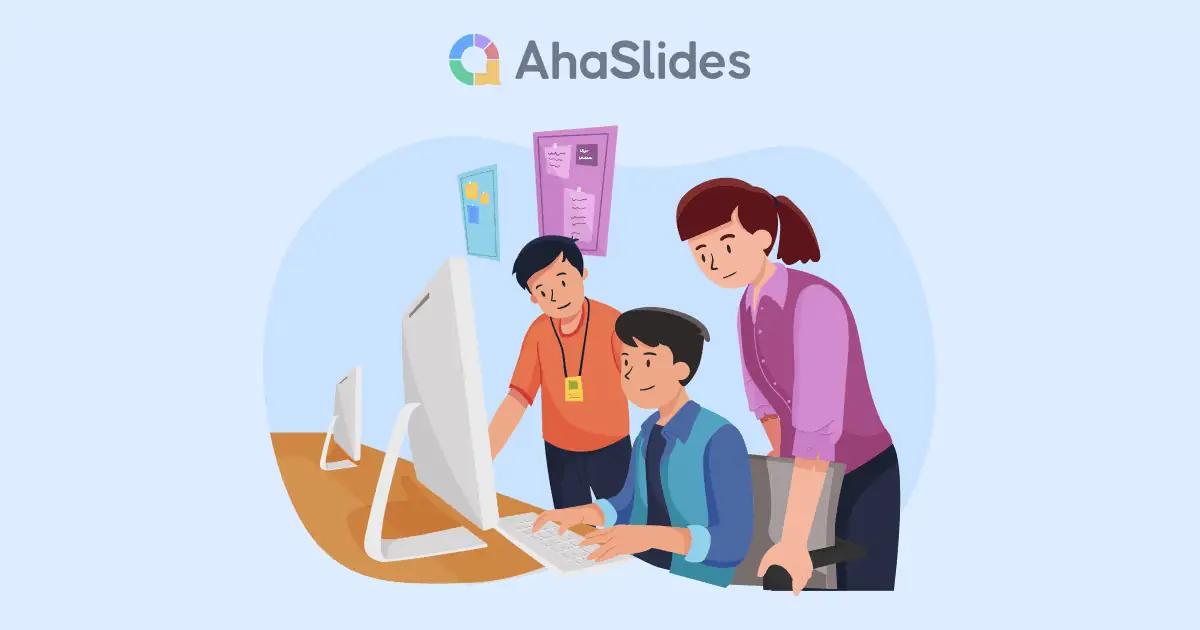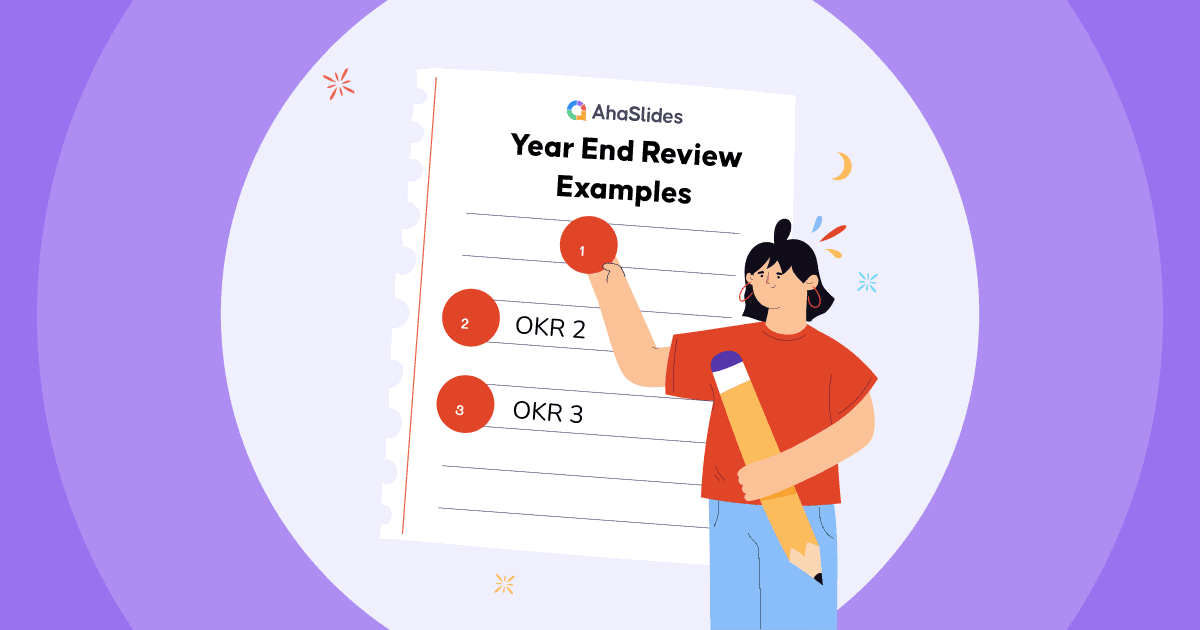क्या आपने कभी खुद को ऐसी स्थिति में पाया है जहाँ आपको कार की कीमत पर मोल-भाव करना पड़ा हो, वेतन वृद्धि के लिए बातचीत करनी पड़ी हो, या किसी स्मारिका के लिए सड़क किनारे विक्रेता से मोल-भाव करना पड़ा हो? अगर ऐसा है, तो आप इसमें शामिल हैं वितरणात्मक मोलभाव, एक मौलिक बातचीत रणनीति जो एक निश्चित संसाधन को विभाजित करने पर केंद्रित है।
इस ब्लॉग पोस्ट में, हम यह पता लगाएंगे कि वितरणात्मक सौदेबाजी क्या है, इसके रोज़मर्रा के उदाहरण क्या हैं, और यह एकीकृत सौदेबाजी से कैसे भिन्न है। हम उन आवश्यक रणनीतियों और युक्तियों पर भी चर्चा करेंगे जो आपको वितरणात्मक परिदृश्यों में अधिक प्रभावी वार्ताकार बनने में मदद कर सकती हैं।
विषय - सूची
- वितरणात्मक सौदेबाजी क्या है?
- वितरणात्मक सौदेबाजी बनाम एकीकृत सौदेबाजी
- वितरणात्मक सौदेबाजी के उदाहरण
- वितरणात्मक सौदेबाजी की रणनीति और रणनीति
- चाबी छीन लेना
- अक्सर पूछे जाने वाले प्रश्न

बेहतर जुड़ाव के लिए टिप्स

सभाओं के दौरान अधिक मज़ा खोज रहे हैं?
AhaSlides पर एक मजेदार क्विज़ के ज़रिए अपने टीम के सदस्यों को इकट्ठा करें। AhaSlides टेम्पलेट लाइब्रेरी से मुफ़्त क्विज़ लेने के लिए साइन अप करें!
🚀 फ्री क्विज ☁️ लें
वितरणात्मक सौदेबाजी क्या है?
वितरणात्मक सौदेबाजी एक बातचीत की रणनीति है जहां दो या दो से अधिक पार्टियां एक निश्चित या सीमित संसाधन को आपस में बांटने का लक्ष्य रखती हैं। इसे ऐसे परिदृश्य के रूप में सोचें जहां आपको पिज्जा को स्लाइस में विभाजित करना है, और हर कोई एक बड़ा टुकड़ा चाहता है। वितरणात्मक सौदेबाजी में, अपने लिए सर्वोत्तम संभव सौदा प्राप्त करने का प्रयास करते हुए पाई के अपने हिस्से को अधिकतम करने का विचार है।
सरल शब्दों में कहें तो यह इस बात पर रस्साकशी की तरह है कि किसे क्या मिलता है। इस तरह की सौदेबाजी में अक्सर प्रतिस्पर्धी हित शामिल होते हैं, जहां एक पक्ष को जो मिलता है, वहीं दूसरा खो सकता है। यह एक जीत-हार की स्थिति है, जहां एक पक्ष जितना अधिक लाभ उठाता है, दूसरे के लिए उतना ही कम होता है
वितरणात्मक सौदेबाजी बनाम एकीकृत सौदेबाजी
वितरणात्मक मोलभाव यह सब आपके हिस्से का दावा करने के बारे में है, जैसे बाज़ार में कीमत पर मोलभाव करना या अपने नियोक्ता के साथ वेतन वृद्धि पर बातचीत करना। आप जितना अधिक प्राप्त करेंगे, दूसरे पक्ष को उतना ही कम प्राप्त होगा।
एकीकृत सौदेबाजी, दूसरी ओर, यह बाज़ार का विस्तार करने जैसा है। कल्पना कीजिए कि आपने और आपके दोस्त ने एक पिज़्ज़ा खाया है, लेकिन आपके पास पेपरोनी, मशरूम और पनीर जैसी कुछ अतिरिक्त टॉपिंग भी हैं। मौजूदा पिज़्ज़ा पर लड़ने के बजाय, आप अपनी पसंद के अनुसार टॉपिंग जोड़कर एक बेहतर पिज़्ज़ा बनाने के लिए मिलकर काम करते हैं। एकीकृत सौदेबाजी एक जीत-जीत दृष्टिकोण है जहां दोनों पक्ष रचनात्मक समाधान खोजने के लिए सहयोग करते हैं जो समग्र मूल्य में वृद्धि करते हैं।
तो, संक्षेप में, वितरणात्मक सौदेबाजी एक निश्चित पाई को विभाजित करने के बारे में है, जबकि एकीकृत सौदेबाजी पारस्परिक रूप से लाभप्रद समाधान ढूंढकर पाई को बड़ा बनाने के बारे में है।

वितरणात्मक सौदेबाजी के उदाहरण
वितरणात्मक सौदेबाजी को बेहतर ढंग से समझने के लिए, आइए कुछ वास्तविक जीवन के उदाहरणों पर नजर डालें जहां यह बातचीत रणनीति काम आती है:
#1 – वेतन वार्ता
कल्पना करें कि आप नौकरी के लिए इंटरव्यू के दौरान संभावित नियोक्ता के साथ अपने वेतन पर चर्चा कर रहे हैं। आप उच्च वेतन चाहते हैं, और वे श्रम लागत को नियंत्रित करना चाहते हैं। यह स्थिति वितरण सौदेबाजी का प्रतिनिधित्व करती है, जहाँ आप दोनों एक निश्चित संसाधन के लिए प्रतिस्पर्धा कर रहे हैं - आपके पद के लिए कंपनी का बजट। यदि आप सफलतापूर्वक बातचीत करते हैं, तो आपको उच्च वेतन मिलता है, लेकिन यह अन्य लाभों या सुविधाओं की कीमत पर आ सकता है।
#2 – कार ख़रीदना
जब आप कार खरीदने के लिए डीलरशिप पर जाते हैं, तो आप वितरण सौदेबाजी में शामिल होने की संभावना रखते हैं। आप सबसे कम संभव कीमत चाहते हैं, जबकि विक्रेता अपना लाभ अधिकतम करना चाहता है। बातचीत कार की कीमत के इर्द-गिर्द घूमती है, और दोनों पक्षों को संतुष्ट करने वाला बीच का रास्ता खोजना चुनौतीपूर्ण हो सकता है।
#3 – तलाक समझौता
जब कोई जोड़ा तलाक से गुजरता है, तो संपत्ति का बंटवारा वितरणात्मक सौदेबाजी का एक उत्कृष्ट उदाहरण हो सकता है। दोनों पक्षों को संपत्ति, बचत और निवेश जैसी साझा संपत्तियों से जितना संभव हो उतना प्राप्त करने में रुचि है। बातचीत का उद्देश्य कानूनी ढांचे और प्रत्येक पति या पत्नी के हितों को ध्यान में रखते हुए इन संसाधनों को उचित रूप से विभाजित करना है।
इनमें से प्रत्येक उदाहरण में, वितरणात्मक सौदेबाजी में एक सीमित या सीमित संसाधन में अपने हिस्से को अधिकतम करने का प्रयास करने वाले पक्ष शामिल होते हैं।
वितरणात्मक सौदेबाजी की रणनीति और रणनीति

वितरण सौदेबाजी में, जहाँ संसाधन सीमित और प्रतिस्पर्धी होते हैं, एक सुविचारित रणनीति और प्रभावी रणनीति का उपयोग आपके वांछित परिणाम को प्राप्त करने में बहुत अंतर ला सकता है। आइए इस प्रकार की बातचीत में उपयोग की जाने वाली प्रमुख रणनीतियों और युक्तियों पर गहराई से विचार करें:
#1 – अपनी स्थिति को स्थिर रखें
पहला प्रस्ताव अक्सर एक लंगर के रूप में कार्य करता है, जो बातचीत की दिशा को प्रभावित करता है। यदि आप विक्रेता हैं, तो उच्च कीमत से शुरू करें। यदि आप खरीदार हैं, तो कम कीमत के प्रस्ताव से शुरू करें। यह माहौल तय करता है और रियायतों के लिए जगह देता है।
#2 – अपना आरक्षण बिंदु निर्धारित करें
अपनी आपत्ति को अपने तक ही सीमित रखें - वह न्यूनतम या उच्चतम स्वीकार्य प्रस्ताव जिसे आप स्वीकार करने को तैयार हैं। इसे बहुत जल्दी प्रकट करने से दूसरे पक्ष को आपकी सीमाएँ जानने का फ़ायदा मिल सकता है।
#3 – रणनीतिक रियायतें दें
रियायतें देते समय, चयनात्मक और रणनीतिक तरीके से ऐसा करें। बहुत जल्दी-जल्दी बहुत कुछ देने से बचें। धीरे-धीरे रियायतें आपकी स्थिति को बनाए रखते हुए लचीलेपन का संकेत दे सकती हैं।
#4 – फ़्लिंच का उपयोग करें
जब कोई प्रस्ताव प्रस्तुत किया जाए, तो रोजगार दें फ़्लिंच रणनीति. आश्चर्य या चिंता के साथ प्रतिक्रिया करें जिससे दूसरा पक्ष उनके प्रस्ताव की निष्पक्षता पर सवाल उठा सके। यह उन्हें अपने प्रस्ताव में सुधार करने के लिए प्रेरित कर सकता है।
#5 – सूचना ही शक्ति है
विषय वस्तु और दूसरे पक्ष की स्थिति पर गहन शोध करें। वितरण सौदेबाजी में ज्ञान एक मूल्यवान हथियार है। आपके पास जितनी अधिक जानकारी होगी, आप प्रभावी ढंग से बातचीत करने के लिए उतने ही बेहतर तरीके से तैयार होंगे।
#6 – समय सीमा बनाएं
समय का दबाव एक मूल्यवान रणनीति हो सकती है। उदाहरण के लिए, यदि आप किसी अनुबंध पर बातचीत कर रहे हैं, तो सौदे के समापन के लिए समय सीमा निर्धारित करने से दूसरे पक्ष को जल्दी निर्णय लेने के लिए प्रेरित किया जा सकता है, जो संभवतः आपके पक्ष में हो।

#7 – सीमित अधिकार का उपयोग करें
दावा करें कि आपके पास निर्णय लेने के लिए सीमित अधिकार हैं। यह एक शक्तिशाली रणनीति हो सकती है, क्योंकि यह धारणा बनाता है कि आप अंतिम निर्णय लेने वाले नहीं हैं। यह दूसरे पक्ष को उच्च अधिकार वाले किसी व्यक्ति से अनुमोदन प्राप्त करने के लिए अधिक पेशकश करने के लिए प्रोत्साहित कर सकता है।
#8 – अच्छा पुलिसवाला, बुरा पुलिसवाला
अगर आप एक टीम के रूप में बातचीत कर रहे हैं, तो अच्छे पुलिस वाले, बुरे पुलिस वाले दृष्टिकोण पर विचार करें। एक वार्ताकार सख्त रुख अपनाता है, जबकि दूसरा अधिक समझौतावादी दिखाई देता है। इससे भ्रम की स्थिति पैदा हो सकती है और रियायतों को बढ़ावा मिल सकता है।
#9 – जब आवश्यक हो तो दूर चले जाएँ
अगर यह स्पष्ट है कि दूसरा पक्ष आपकी न्यूनतम आवश्यकताओं को पूरा करने के लिए तैयार नहीं है, तो बातचीत से दूर जाने के लिए तैयार रहें। कभी-कभी, बातचीत की मेज से उठ जाना सबसे शक्तिशाली रणनीति होती है।
चाबी छीन लेना
वितरण सौदेबाजी आपके शस्त्रागार में होना एक मूल्यवान कौशल है। चाहे आप पिस्सू बाजार में सौदेबाजी कर रहे हों, वेतन वृद्धि के लिए बातचीत कर रहे हों, या कोई व्यापारिक सौदा कर रहे हों, वितरण सौदेबाजी की रणनीतियों और युक्तियों को समझने से आपको अपने या अपने संगठन के लिए सर्वोत्तम संभव परिणाम प्राप्त करने में मदद मिल सकती है।
और यह मत भूलिए कि चाहे आप अपनी बातचीत कौशल को निखार रहे हों, प्रभावशाली प्रस्तुतियाँ दे रहे हों, या बिक्री टीमों को सफल बनाने के लिए प्रशिक्षण दे रहे हों, इसकी क्षमता पर विचार करें। अहास्लाइड्स सफलता की ओर आपकी यात्रा का समर्थन करने के लिए। हमारे साथ अपनी सामग्री को अगले स्तर पर ले जाएं इंटरैक्टिव टेम्पलेट्स जो विभिन्न आवश्यकताओं और उद्योगों को पूरा करता है। आपके दर्शक आपको धन्यवाद देंगे.
अक्सर पूछे जाने वाले प्रश्न
वितरणात्मक बनाम एकीकृत सौदेबाजी क्या है?
वितरणात्मक मोलभाव: यह एक पाई को विभाजित करने जैसा है। पार्टियाँ एक निश्चित संसाधन के लिए प्रतिस्पर्धा करती हैं, और जो एक पक्ष को मिलता है, वह दूसरे को खो सकता है। इसे अक्सर जीत-हार के रूप में देखा जाता है।
एकीकृत सौदेबाजी: इसे पाई का विस्तार करने के रूप में सोचें। पार्टियाँ रचनात्मक समाधान खोजने के लिए सहयोग करती हैं जो बातचीत किए जा रहे संसाधनों के समग्र मूल्य को बढ़ाती हैं। यह आम तौर पर जीत-जीत है।
क्या वितरणात्मक सौदेबाजी फायदे का सौदा है?
वितरणात्मक सौदेबाजी आम तौर पर जीत-जीत वाली नहीं होती। यह अक्सर जीत-हार की स्थिति पैदा करती है, जहां एक पक्ष का लाभ दूसरे पक्ष के लिए नुकसानदेह होता है।
रेफरी: नवभारत टाइम्स | अमेरिकन एक्सप्रेस








